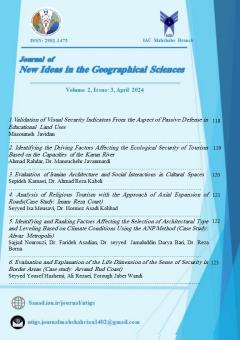Identifying and Ranking Factors Affecting the Selection of Architectural Type and Leveling Based on Climate Conditions Using the ANP Method (Case Study: Ahvaz Metropolis)
Subject Areas : Geography and Urban PlanningSajad Norouzi 1 , Dr.Farideh Asadian 2 , Dr.Seyyed Jamaloddin Daryabari 3 , Dr.Reza Borna 4
1 - Ph,D Student, Urban Climatology Department, Science and Research Branch, Islamic Azad University, Tehran, Iran.
2 - Assistant Professor, Urban Planning Department, Science and Research Branch, Islamic Azad University, Tehran, Iran.
3 - Associate Professor, Urban Planning Department, Science and Research Branch, Islamic Azad University, Tehran, Iran.
4 - Associate Professor, Geography Department, Ahwaz Branch, Islamic Azad University, Ahvaz, Iran
Keywords: Climate, Architecture, Leveling, Ahvaz Metropolis, ANP Method,
Abstract :
The present study aimed to identify and rank the factors affecting the selection of architecture and leveling of educational centers according to climate conditions using the ANP method. Library and field methods were used to collect data. Data collection tools were databases related to climatology in the Ahvaz metropolis. To weigh each factor, the opinions of experts and ANP were used. The factors were also ranked based on the weight of each factor. The results revealed that pollution prevention with a weight of 0.099, sunny hours with a weight of 0.099, and access with a relative weight of 0.096 had the highest weights among the obtained sub-indices. Thus, they were ranked first to third, respectively. Other sub-indicators were placed in other ranks based on the weights obtained.
1) آرینپور، شایا(1393). نقش عوامل اقلیمی در طراحی ساختمان های پایدار شهر اهواز. نقش عوامل اقلیمی در طراحی ساختمان های پایدار شهر اهواز، همایش ملی مهندسی عمران، معماری و مدیریت پایدار شهری.
2) حسین پور, امین (1394). راهنمای طراحی اقلیمی برای اقلیم گرم و مرطوب نمونه موردی شهر اهواز، اولین کنفرانس ملی جغرافیا و برنامه ریزی، معماری و شهرسازی نوین، قم، مرکز مطالعات و تحقیقات اسلامی سروش حکمت مرتضوی.
3) حجازیزاده، زهرا، کربلایی، علیرضا، وکردوانی، پرویز(1394). اقلیم آسایش حرارتی و شاخص های آن(به همراه نرم افزار tcic)، تهران. انتشارات قفنوس.
4) رضائیزاده مهابادی, کامران و مریم تبریزی، (1396). بررسی راهکارهای طراحی اقلیمی در معماری بناهای سنتی یزد ( مطالعه موردی: خانه رسولیان- مدرسه ایرانشهر). دومین کنفرانس ملی پژوهش های کاربردی در مهندسی عمران(مهندسی سازه و مدیریت ساخت). تهران، دانشگاه صنعتی شریف
5) ریاحی، جمال(1395). نقش اقلیم و معماری بر هویت بخشی شهر اهواز. موسسه آموزش عالی باختر ایلام - دانشکده جغرافیا، پایان نامه کارشناسی ارشد.
6) سجادزاده, حسن، فاطمه اصیلیان بیدگلی، وسادات چاوشیزاده، فریده (1394). راهکارهای طراحی اقلیمی در معماری بناهای سنتی یزد، همایش ملی عمران و معماری با رویکردی بر توسعه پایدار، فومن، دانشگاه آزاد اسلامی واحد فومن و شفت.
7) کامیابی،سعید، ومیرزایی، رضا (1401). تطبیق معماری با اقلیم بر اساس شاخص های حرارتی نمونه موردی: اقلیم سرد و خشک مشهد. نشریه مطالعات اجتماعی خراسان.10(2).119-141.
8) لشکری، حسن، موزرمی، سارا، سلکی، هیوا، و لطفی، کوروش. (1402). بهینه سازی جهت گیری بناهای ساختمانی در شهر اهواز بر اساس شرایط اقلیمی. نشریه جغرافیای طبیعی، 4(12)، 45-62.
9) مهدوینژاد، محمدجواد، منصورپور، مجید، ومسعودینژاد، مصطفی(1395). جایگاه اقلیم در ترکیب بندی بناهای معاصر . نشریه هویت شهر، 26(10).61-74.
10) مولانایی، صلاح الدین، وسلیمانی، سارا (1395). عناصر باارزش معماری بومـی منطقه سـیسـتان؛ بر مبنای مولفههای اقلیمی معماری پایدار، نشریه باغ نظر، 13(4).57-66.
11) وفا، مقدسه (1396). تاثیر عوامل اقلیمی معتدل و مرطوب در طراحی ساختمان سبز و راه رسیدن به طراحی پایدار، دومین همایش بین المللی افق های نوین در مهندسی عمران، معماری و شهرسازی و مدیریت فرهنگی شهرها، تهران، انجمن افق نوین علم و فناوری.
12) Alahmer, A.; Abdelhamid, M.; Omar(2023). Design for thermal sensation and comfort states in vehicles cabins. Appl. Therm. Engeriing journal, 36, 126–140
13) Berek,K,Hizly,N(2016). Learning from Vernacular Architecture: Ecological Solutions in Traditional Erzurum Houses . Procedia - Social and Behavioral Sciences, 216(6).788-799.
14) Lamb,W,Minx.Z (2020). The political economy of national climate policy: Architectures of constraint and a typology of countries. Energy Research & Social Science, 64(4).101-429.
15) Lee, Q.(2022). Human comfort and perceived air quality in warm and humid environments with ceiling fans. Build Environ, 90, 178–185
16) Lozoya-Peral A, Pérez-Carramiñana C, Galiano-Garrigós A, González-Avilés ÁB, Emmitt S(2023). Exploring Energy Retrofitting Strategies and Their Effect on Comfort in a Vernacular Building in a Dry Mediterranean Climate. Building and Environment, 13(6):1381.
17) Kosir,M(2018). Implications of present and upcoming changes in bioclimatic potential for energy performance of residential buildings. Building and Environment.127(2).157-172.
18) Mazraeh,H,Pazhuhafar,M(2018). Effects of vernacular architecture structure on urban sustainability case study: Qeshm Island, Iran. Frontiers of Architectural Research.7(1).11-24.
19) Pfafferott, J.; Herkel, S.; Jäschke, M. (2023).Design of passive cooling by night ventilation: Evaluation of a parametric model and building simulation with measurements. Energy Build, 35, 1129–1143.
20) Premorv,M.Zigrat,M,Vesna,L(2018). Influence of the building shape on the energy performance of timber-glass buildings located in warm climatic regions. Energy, 149(15).496-504
21) Varzaneh,L,Armini,M.Bemarian,M(2014). Impact of Hot and Arid Climate on Architecture. Procedia Engineering, 94(2).25-32.
22) Ye,W,Zhang,F,Bai,W,Due,Z(2019). A tile service-driven architecture for online climate analysis with an application to estimation of ocean carbon flux. Environmental Modelling & Software.118(34).120-133.


